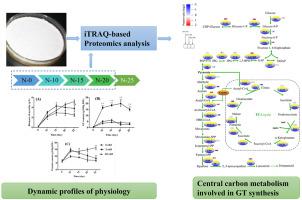当前位置:
X-MOL 学术
›
Fungal Biol.
›
论文详情
Our official English website, www.x-mol.net, welcomes your
feedback! (Note: you will need to create a separate account there.)
Time-scale dynamics of proteome predicts the central carbon metabolism involved in triterpenoid accumulation responsive to nitrogen limitation in Ganoderma lucidum
Fungal Biology ( IF 2.9 ) Pub Date : 2020-12-01 , DOI: 10.1016/j.funbio.2020.11.009 Danhong Lian 1 , Lian Li 2 , Xin Liu 1 , Xin Zhong 1 , Haizhen Wang 1 , Sha Zhou 1 , Li Gu 1
Fungal Biology ( IF 2.9 ) Pub Date : 2020-12-01 , DOI: 10.1016/j.funbio.2020.11.009 Danhong Lian 1 , Lian Li 2 , Xin Liu 1 , Xin Zhong 1 , Haizhen Wang 1 , Sha Zhou 1 , Li Gu 1
Affiliation

|
Abstract Central carbon metabolism (CCM) describes the integration of transport pathway of main carbon sources inside the cell. Nitrogen (N) limitation is a favorable approach to stimulate ganoderic triterpenoid (GT) accumulation in G. lucidum. In this study, the dynamic regulation of metabolism reassignment towards GT biosynthesis responsive to N limitation in G. lucidum was investigated by iTRAQ-based proteome. Physiological data suggested that N limitation slightly affected cell growth but significantly enhanced GT contents in the initial 20 days. From day 10, the protein contents were halted by prolonged N limitation duration. Proteomics-based investigations revealed that the carbon skeletons integrated into GT precursors were regenerated by glycolysis and the tricarboxylic acid (TCA) cycle. Cells strategically reserved nitrogen by barely incorporating it into TCA cycle intermediates to form amino acids, and enzymes involved in protein degradation were up regulated. Furthermore, regulation of proteins in response to abiotic stress and oxidation-reduction processes played a critical role in maintaining cellular homeostasis during N limitation. These findings indicated that the flux of carbon into GT following N deficiency was a consequence of the remodeling of intermediate metabolism in TCA cycle and glycolysis reactions. This study provides a rationale for genetic engineering of G. lucidum, which may enable synchronized biomass and GT synthesis.
中文翻译:

蛋白质组的时间尺度动态预测灵芝中响应氮限制的三萜积累中涉及的中心碳代谢
摘要 中央碳代谢(CCM)描述了细胞内主要碳源转运途径的整合。氮 (N) 限制是刺激灵芝中灵芝三萜 (GT) 积累的有利方法。在这项研究中,通过基于 iTRAQ 的蛋白质组研究了灵芝中响应 N 限制的代谢重新分配对 GT 生物合成的动态调节。生理数据表明,在最初的 20 天内,氮限制对细胞生长有轻微影响,但显着提高了 GT 含量。从第 10 天起,蛋白质含量因延长 N 限制持续时间而停止。基于蛋白质组学的研究表明,整合到 GT 前体中的碳骨架是通过糖酵解和三羧酸 (TCA) 循环再生的。细胞通过将氮几乎不掺入 TCA 循环中间体以形成氨基酸来战略性地保留氮,并且参与蛋白质降解的酶被上调。此外,响应非生物胁迫和氧化还原过程的蛋白质调节在氮限制期间维持细胞稳态方面发挥了关键作用。这些发现表明,在 N 缺乏后,碳流入 GT 是 TCA 循环和糖酵解反应中中间代谢重塑的结果。该研究为灵芝基因工程提供了基本原理,这可能使生物量和 GT 合成同步。响应非生物胁迫和氧化还原过程的蛋白质调节在氮限制期间维持细胞稳态方面发挥了关键作用。这些发现表明,在 N 缺乏后,碳流入 GT 是 TCA 循环和糖酵解反应中中间代谢重塑的结果。该研究为灵芝基因工程提供了基本原理,这可能使生物量和 GT 合成同步。响应非生物胁迫和氧化还原过程的蛋白质调节在氮限制期间维持细胞稳态方面发挥了关键作用。这些发现表明,在 N 缺乏后,碳流入 GT 是 TCA 循环和糖酵解反应中中间代谢重塑的结果。该研究为灵芝基因工程提供了基本原理,这可能使生物量和 GT 合成同步。
更新日期:2020-12-01
中文翻译:

蛋白质组的时间尺度动态预测灵芝中响应氮限制的三萜积累中涉及的中心碳代谢
摘要 中央碳代谢(CCM)描述了细胞内主要碳源转运途径的整合。氮 (N) 限制是刺激灵芝中灵芝三萜 (GT) 积累的有利方法。在这项研究中,通过基于 iTRAQ 的蛋白质组研究了灵芝中响应 N 限制的代谢重新分配对 GT 生物合成的动态调节。生理数据表明,在最初的 20 天内,氮限制对细胞生长有轻微影响,但显着提高了 GT 含量。从第 10 天起,蛋白质含量因延长 N 限制持续时间而停止。基于蛋白质组学的研究表明,整合到 GT 前体中的碳骨架是通过糖酵解和三羧酸 (TCA) 循环再生的。细胞通过将氮几乎不掺入 TCA 循环中间体以形成氨基酸来战略性地保留氮,并且参与蛋白质降解的酶被上调。此外,响应非生物胁迫和氧化还原过程的蛋白质调节在氮限制期间维持细胞稳态方面发挥了关键作用。这些发现表明,在 N 缺乏后,碳流入 GT 是 TCA 循环和糖酵解反应中中间代谢重塑的结果。该研究为灵芝基因工程提供了基本原理,这可能使生物量和 GT 合成同步。响应非生物胁迫和氧化还原过程的蛋白质调节在氮限制期间维持细胞稳态方面发挥了关键作用。这些发现表明,在 N 缺乏后,碳流入 GT 是 TCA 循环和糖酵解反应中中间代谢重塑的结果。该研究为灵芝基因工程提供了基本原理,这可能使生物量和 GT 合成同步。响应非生物胁迫和氧化还原过程的蛋白质调节在氮限制期间维持细胞稳态方面发挥了关键作用。这些发现表明,在 N 缺乏后,碳流入 GT 是 TCA 循环和糖酵解反应中中间代谢重塑的结果。该研究为灵芝基因工程提供了基本原理,这可能使生物量和 GT 合成同步。











































 京公网安备 11010802027423号
京公网安备 11010802027423号